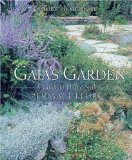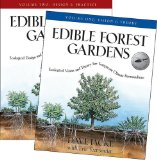| Work with Nature to grow food in a low-maintenance, sustainable, perennial garden. |
| ABOUT US START IDEAS DO LESS USEFUL PLANTS PROJECTS VIEWS RESOURCES TOPICS |
|
|
|||
Everyone loves the idea of homegrown produce, but in reality, it is a lot of work for those of us living in temperate zones. Many of our favorite food crops—carrots, tomatoes, squash, lettuce, beans, melons—must be planted anew every year. Most of the work happens in spring and fall. We must prepare the soil every year, plant every year (sometimes more than once during the growing season), and maybe start seeds indoors before the last spring frost and protect delicate crops after the first autumn frost. Then there is cleanup in fall after the plants have died. The typical vegetable garden is also resource-intensive; plants may need to be mulched, fertilized, and/or watered regularly throughout the season. And unless seeds are saved, new seeds or seedlings must be bought every year. But there is another way to grow food. Many food plants can live through winters, even in northern climates, and bear food every year. Hardy perennial food plants include common vegetables like asparagus and rhubarb, herbs like thyme and sage, and fruiting plants from groundcover strawberries to caning blackberries and shrubby currants to tree crops like apples, cherries, pears, and hazelnuts. They also include less common crops, crops that native Americans used as well as food plants from other parts of the world. Like Jerusalem artichokes, which are the tuberous roots of a member of the sunflower family. Or the British foliage plants known as potherbs, which include Good King Henry, sorrel, lovage, lemon balm, and other perennials whose leaves were eaten raw in salads and also used to add flavor and nutrients to soups and hot dishes. Once they are settled in your garden, these plants grow and bear more crops as the years pass, and most of them demand less work with each passing year. There's no replanting, no tilling the soil, no yanking out and disposing of dead plants. There is only a minimal amount of caring for the live plants, and of course, harvesting the food. Welcome to the world of forest gardening, a key aspect of permaculture. Forest gardens are communities of perennial plants—from trees down to groundcovers and including plants of varied sizes and habits, many of which produce food for people, and many others of which work to keep the plant community healthy by doing such jobs as attracting pollinators, suppressing weeds, and converting airborne nitrogen to a form other plants can use. The biggest work of a forest garden lies in its design. This entails thinking through, as clearly as possible, how plants will perform in the chosen site, and even more importantly, how they will interact with each other and the local fauna, and using these thoughts to choose the members of your plant community. The process may sound daunting, but little enough is known about forest gardening that there are few accepted norms in this young field, so you can experiment with impugnity. Remember, gardening is serious play! To read up on what is known, see the references at right. Here are a few forest gardening concepts to whet your appetite: Plants partition resources. In a stable plant community, the members use as much of the available sunlight, water, and nutrients as possible. To do this, they grow at different heights; have differently structured roots; leaf out, flower, and set fruit at different times; and manufacture a wide array of chemicals for protection, advertising, and other functions. A well-chosen community of plants that uses all the resources can resist intrustions by most other species. Conversely, if a surplus of some resource goes unused, an opportunistic new plant will move into the community. Stagger your harvest. Design your edible garden with the harvest dates for each species in mind. Choose different varieties of a certain food to extend the season during which you'll have it fresh (i.e. apples that fruit at different times). Also plant similar foods that expand your season even further (i.e., in addition to apples, plant plums, persimmons, and apricots). Plan disturbance and revegetation together. You can use disturbances like weed-pulling or brush-cutting as ways to direct succession, the natural process by which certain plants come to dominate an area. The key is to fill any gaps as soon as you create them. Disturbed soil releases a flood of nutrients that will boost the chances of success for the plants that arrive first on the scene. You can choose those plants, and if they are appropriate to the place, nature will favor them over unsolicited later arrivals. Similarly, pruning up woodies lets a flood of light into an area, and plants that are in a position to take advantage of it will compete to use it. Make sure it's accessible to your chosen plants, and they will grow to use it, blocking unwanted plants. The above concepts offer a tiny taste of the mouth-watering cornucopia of knowledge that forest gardening and permaculture hold in store. If you want to learn how nature works and use that knowledge to increase your garden's health and your own, grow some perennial food plants this year! |
For more info about growing perennial foods, see these resources:  In Gaia's Garden, author Toby Hemenway will get you excited about the possibilities. He'll tell you ways plants can help you and each other and give you details about how growing your own food will cut down on your personal energy footprint. info at Amazon  Move on to Edible Forest Gardens, a two-volume set. Volume 1 (theory) explores current ecological knowledge, while Volume 2 (practice) shows you how to apply cutting-edge ecological research to design a prosperous permanent food garden. It also offers tables showing many plants' habits, uses, and ecological functions within a community. info at Amazon |
||
|
Thanks for visiting http://www.LessLawn.com! All site contents © 2001-2013 Evelyn J. Hadden, except where noted. All rights reserved. |